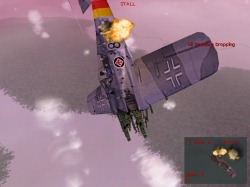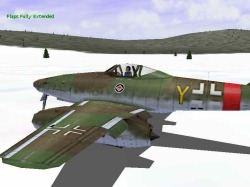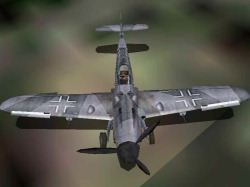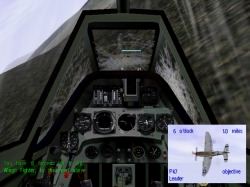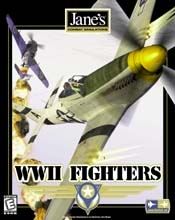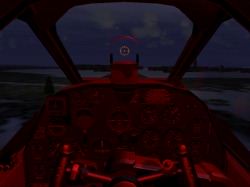| Janes WW2 Fighters, Part II by Thomas "AV8R" Spann |
||||
|
OK already, enough of the hot graphics you say. So what is all this going to cost me to run this on my rig? Well, the box recommends a P2 300 or better, 64 MB RAM, 300 MB HDD, X8+ CDROM, and a 3DFX based 3D graphics card. It requires at least a P200 CPU, 32 MB RAM, 200 MB HDD plus 50 MB Windows swap file, and a Glide, D3D or OpenGL graphics accelerator card. Face it, this sim is not going to look and run great on technology more than a full year old (I recommend EAW if you are on older hardware). On my P2 300 rig with a 12 MB Voodoo2 card, I was getting 18 FPS over terrain and upwards of 58 FPS with all blue sky around the plane. That was with all the details and options turned all the way to max. So mileage will vary upon what you do with the settings. Yes, WW2 Fighters is a special effects wonder, but you will have to have the hardware to get the full bang for your buck.
The next major areas of interest to me are flight modeling (FM) and its kissing cousins: damage modeling and object physics. Apart from multiplayer aspects, this is the heart and soul of what defines a flight sim to be of what genre of sophistication (i.e. easy, mid-level or hard-core). For the sake of being complete, I will define my terms and state my rule of thumb for characteristics of these three ratings. An "easy level" sim is one where the learning curve is very short for even the novice simmer, basically a yankem and bankem arcade styles sim. Some examples would be: Jane’s USNF, Lucas Arts Xwing vs. Tie Fighter, F22 Raptor. A "mid-level" sim goes deeper into the flight modeling, on line features, avionics, mission editing, and campaigning. This level of sophistication usually requires the simmer to actually crack the manual open and do some homework. Energy tactics are now coming into play, and the flight model makes you take notice of spins, stalls, weapon envelopes, etc. Some good examples would be: Nova Logic’s recent F-16 MRF and MiG-29 pair, Hornet Korea, EF2000, Total Air War, RedBaron2 and Jane’s IAF. Finally, a "hard-core" sim (where my tastes lie) are everything that mid-level sims have plus a higher level of detail in the flight modeling, object physics, viewing/padlock system, mission editing and generation, detailed campaign engine and pilot statistics, AI modeling and very good multiplayer support - both H2H and COOP. Fine examples would be: SSI’s Su27 Flanker, WarBirds, Jane’s F15E and LongBow2, iF-18, EAW, FC-Gold, MS-CFS, Falcon3 (for it's day) and Falcon4.
Now you may disagree with my classifying some of these games into one of these categories, but the fact is that it's just my opinion and a lot of these are fence sitters that could easily go either way. For example, is TAW closer to being hard-core with its very broad product features, or does it belong in mid-range due to its rather easy flight model? For me, the flight model is the major component in what is hard-core or not. I’m sure we all will draw that fine line differently, but for argument’s sake this is how I rate sims. Now back to rating WW2 Fighters along this scale. |
When it comes to flight model, WW2 Fighters falls short of being truly hard-core. This came to be a real disappointment to me personally for two reasons. First I’ve looked up to Jane’s to be THE hard-core sim developer lately. With products like Longbow2 and F15-E, I had hoped for a top notched flight model following these other releases. Secondly, with the media and marketing hype as I previously quoted, my expectations were set high. They mention a high level of realism. If that means graphics and sounds, OK, I agree. But if this was meant to imply realistic flight dynamics; then I have to say that WW2 Fighters does NOT deliver. Why? While the feel of flight is very good, the hard-core simmer looks for flight behavior at the edge of control. That is to say, departure characteristics: flight dynamics such as spins, stalls, compressibility, and faithfulness to known flight specifications.
I confess that I am not an aeronautical engineer. But I am an engineer who has flown and studied WW2 era planes as well as spent many hundreds of hours in Fighter Duel and Warbirds - what I consider to be the benchmarks for WW2 flight sim modeling. What I noticed with WW2 Fighters is that the stalls are good, requiring energy management as I would expect. But the spin nature is very weak.
While set to the HARD setting for flight model (note that I dislike any variable flight model option; if it has to exist, it better be globally set by the multiplayer host), I would do MAX-G turns at low speeds and could not get into a hard spin. Easy spins, yes, but hard to recover spins were not to be had. Even high AOA were easily obtained with little effect on performance. Both Warbirds and EAW have very believable spin and AOA modeling - as such I rated these two sims as hard-core. I hope Jane’s reads this review and patches this HARD setting to be what it should be… HARD. Else why bother with a variable model feature? I also dislike the auto pilot feature that lets you sit back and let the computer dogfight and mud strike without your assistance. I would much rather see an auto pilot that kicks out when you’re within a certain radius of combat or tactical triggers. Rowan’s WW1 Flying Corps Gold did this very nicely. It is for these reasons that I rate Jane’s WW2 Fighters FM as mid-level. Now let's talk about what I LIKE about this sim...
Go to part III
|
|||
|
© 1997 - 2000 COMBATSIM.COM, INC. All Rights Reserved. Last Updated December 1st, 1998 |
||||

